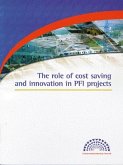S P Deolalkar
Nomograms for Design and Operation of Cement Plants
S P Deolalkar
Nomograms for Design and Operation of Cement Plants
- Broschiertes Buch
- Merkliste
- Auf die Merkliste
- Bewerten Bewerten
- Teilen
- Produkt teilen
- Produkterinnerung
- Produkterinnerung
A unique publication, this set of book and CD-ROM is a handy tool for the design and operation of cement plants. Operation requires many calculations that have to be done repetitively. With this book of nomograms - graphical representations of two or more variables related to one another in such a way that a third one can be read from the nomogr
Andere Kunden interessierten sich auch für
![Asset Management of Bridges Asset Management of Bridges]() Asset Management of Bridges60,99 €
Asset Management of Bridges60,99 €![Site Investigation using Resistivity Imaging Site Investigation using Resistivity Imaging]() Sahadat HossainSite Investigation using Resistivity Imaging72,99 €
Sahadat HossainSite Investigation using Resistivity Imaging72,99 €![Earthen Architecture: Past, Present and Future Earthen Architecture: Past, Present and Future]() Earthen Architecture: Past, Present and Future176,99 €
Earthen Architecture: Past, Present and Future176,99 €![Analysis of Pile Foundations Subject to Static and Dynamic Loading Analysis of Pile Foundations Subject to Static and Dynamic Loading]() Analysis of Pile Foundations Subject to Static and Dynamic Loading58,99 €
Analysis of Pile Foundations Subject to Static and Dynamic Loading58,99 €![The Role of Cost Saving and Innovation in Pfi Projects The Role of Cost Saving and Innovation in Pfi Projects]() Construction Industry CouncilThe Role of Cost Saving and Innovation in Pfi Projects119,99 €
Construction Industry CouncilThe Role of Cost Saving and Innovation in Pfi Projects119,99 €![Urban Water Cycle Processes and Interactions Urban Water Cycle Processes and Interactions]() Jiri MarsalekUrban Water Cycle Processes and Interactions62,99 €
Jiri MarsalekUrban Water Cycle Processes and Interactions62,99 €![Tile Drainage; Or, Why, Where, When, and How to Drain Land With Tiles: A Practical Book for Practical Framers Tile Drainage; Or, Why, Where, When, and How to Drain Land With Tiles: A Practical Book for Practical Framers]() W. I. ChamberlainTile Drainage; Or, Why, Where, When, and How to Drain Land With Tiles: A Practical Book for Practical Framers20,99 €
W. I. ChamberlainTile Drainage; Or, Why, Where, When, and How to Drain Land With Tiles: A Practical Book for Practical Framers20,99 €-
-
-
A unique publication, this set of book and CD-ROM is a handy tool for the design and operation of cement plants. Operation requires many calculations that have to be done repetitively. With this book of nomograms - graphical representations of two or more variables related to one another in such a way that a third one can be read from the nomogr
Produktdetails
- Produktdetails
- Verlag: CRC Press
- Seitenzahl: 272
- Erscheinungstermin: 14. Oktober 2024
- Englisch
- Abmessung: 280mm x 210mm
- Gewicht: 500g
- ISBN-13: 9781032931012
- ISBN-10: 1032931019
- Artikelnr.: 71650214
- Herstellerkennzeichnung
- Libri GmbH
- Europaallee 1
- 36244 Bad Hersfeld
- gpsr@libri.de
- Verlag: CRC Press
- Seitenzahl: 272
- Erscheinungstermin: 14. Oktober 2024
- Englisch
- Abmessung: 280mm x 210mm
- Gewicht: 500g
- ISBN-13: 9781032931012
- ISBN-10: 1032931019
- Artikelnr.: 71650214
- Herstellerkennzeichnung
- Libri GmbH
- Europaallee 1
- 36244 Bad Hersfeld
- gpsr@libri.de
S.P. Deolalkar graduated in Mechanical and Electrical Engineering and at the British Institute of Management. As and Engineer, he joined the Associated Cement Companies, followed by ACC-Vickers-Babcock, where he was engaged in the manufacturing of boilers and cement machinery. He then continued as the Chief Executive of Bhagwati Priya Consulting Engineers and subsequently founded Deolalkar Consultants. He has been involved with the cement industry for many years and gathered experience and expertise in the commissioning, design, construction and operation of new plants as well as in extending and upgrading existing plants. Having handled almost all aspects of cement plants design, ranging form small 300 tpd to 3000 tpd capacities, Mr Deolalkar authored the reference work 'Handbook for Designing Cement Plants' (BS Publications / CRC Press, 2009, ISBN 978-0-415-66577-3), which is complemented with this practical nomogram book.
1. Basics (capacities and rates of overall cement plant; crushing
grinding; feed rates in various sections with necessary margins; quality calculations
such as the proportioning of raw materials and for arriving at related parameters; carbonates
oxides and ratios of raw meal to clinker); 2. Physical (temperatures
altitudes
atmospheric pressures and densities; areas and volumes ; volumes of silos and stock piles; half angle at centre of mills and kilns and related variables; aspects of system design); 3. Processes (calculations related to calorific values of fuel and its consumption
combustion and drying; log mean temperature difference; heat content of air
clinker
calculations related to cooling)
and 4. Machinery (ball mill design
vertical roller mills
preheater design
fuel fired in calciner
kiln capacity impact
kiln sizing and design
conventional clinker coolers
pneumatic conveying
mechanical conveyors
bag filter sizing
SCAs or ESPs for different efficiencies).
grinding; feed rates in various sections with necessary margins; quality calculations
such as the proportioning of raw materials and for arriving at related parameters; carbonates
oxides and ratios of raw meal to clinker); 2. Physical (temperatures
altitudes
atmospheric pressures and densities; areas and volumes ; volumes of silos and stock piles; half angle at centre of mills and kilns and related variables; aspects of system design); 3. Processes (calculations related to calorific values of fuel and its consumption
combustion and drying; log mean temperature difference; heat content of air
clinker
calculations related to cooling)
and 4. Machinery (ball mill design
vertical roller mills
preheater design
fuel fired in calciner
kiln capacity impact
kiln sizing and design
conventional clinker coolers
pneumatic conveying
mechanical conveyors
bag filter sizing
SCAs or ESPs for different efficiencies).
1. Basics (capacities and rates of overall cement plant; crushing
grinding; feed rates in various sections with necessary margins; quality calculations
such as the proportioning of raw materials and for arriving at related parameters; carbonates
oxides and ratios of raw meal to clinker); 2. Physical (temperatures
altitudes
atmospheric pressures and densities; areas and volumes ; volumes of silos and stock piles; half angle at centre of mills and kilns and related variables; aspects of system design); 3. Processes (calculations related to calorific values of fuel and its consumption
combustion and drying; log mean temperature difference; heat content of air
clinker
calculations related to cooling)
and 4. Machinery (ball mill design
vertical roller mills
preheater design
fuel fired in calciner
kiln capacity impact
kiln sizing and design
conventional clinker coolers
pneumatic conveying
mechanical conveyors
bag filter sizing
SCAs or ESPs for different efficiencies).
grinding; feed rates in various sections with necessary margins; quality calculations
such as the proportioning of raw materials and for arriving at related parameters; carbonates
oxides and ratios of raw meal to clinker); 2. Physical (temperatures
altitudes
atmospheric pressures and densities; areas and volumes ; volumes of silos and stock piles; half angle at centre of mills and kilns and related variables; aspects of system design); 3. Processes (calculations related to calorific values of fuel and its consumption
combustion and drying; log mean temperature difference; heat content of air
clinker
calculations related to cooling)
and 4. Machinery (ball mill design
vertical roller mills
preheater design
fuel fired in calciner
kiln capacity impact
kiln sizing and design
conventional clinker coolers
pneumatic conveying
mechanical conveyors
bag filter sizing
SCAs or ESPs for different efficiencies).








